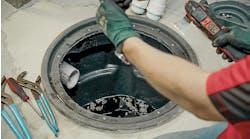Corrugated stainless steel tubing (CSST) has been widely used for natural and propane gas systems. Not all mechanical contractors embraced CSST, but the potential labor savings certainly were attractive enough to convince most installers to incorporate CSST into the mix, especially in new construction where competitive bidding can be fierce.
Stray voltages from lightening strikes have caused a few ungrounded gas systems that incorporate CSST to develop a pinhole where the current arced to a grounded part of the structure. Fires and, in a few cases, total loss of the structure have occurred and, quite naturally, lawsuits arose. In at least one case I’m aware of, a mechanical contractor simply pointed out to the homeowner that their CSST piping wasn’t grounded and suggested they contact an electrician to have that done. Lightening arrived before the homeowner called an electrician: the resulting arc burned a pinhole through the CSST, a fire destroyed their home, and my friend (the mechanical contractor) was named in the lawsuit. Never mind that he had not touched their gas piping, wasn’t the installer, and simply advised them to have a proper bonding to ground installed — he reported it and therefore gets dragged into the legal tangle. No good deed goes unpunished! You know what happens.
Stray voltagesounds like a homeless dog full of static electricity! If you’re a well-water pump dealer, you already know how stray voltage from lightening strikes can travel great distances underground and zap the pump motor, burn through 12-gauge wiring or whack pump controls. A bad lightening storm often equates to pump calls the next day. Cha-ching for the plumber. A CSST related fire equals lawsuit. Cha-ching for the lawyer. There are CSST piping systems designed to resist damage from lightening-strike stray voltage and their conductive jacket can eliminate the requirement to bond the gas piping system. For the CYA (cover your ass-sets) proper bonding provides, my money is on incorporating the added measure of safety. You never know who may one day come along and compromise the system by adding CSST without the added conductive jacket!
In a recent class on this issue, the instructor equated bonding to ground within the home to filling a bathtub with water. “Think of ungrounded CSST piping like a hole in that tub where water (stray voltage) can leak out,” he said. “You need to plug up any points where leaks can develop.” He suggested it would be great if you can get the electrician to handle this job, but not to rely solely on that getting done by others: “Follow up and check to ensure it has been done, and, done properly.”
Bond to ground
Where to bond to ground? “On the delivery side of the meter and before the first piece of CSST utilized,” the instructor said. If the home’s grounding rod is nearby the gas meter, he suggested you may want to clean off rust/paint from the delivery-side black iron piping, attach a listed grounding-clamp, run No. 6 copper (or No. 4 aluminum, which oxidizes and requires a protective anti-oxidant and has, itself, been controversial with arcing and related fire-damage issues, so I’m sticking with copper) and attach to the ground rod. NEC 2008 (National Electric Code) 250.7 requires grounding be attached using a listed connector. The outdoor ground-rod clamp already in place must, by NEC code, be listed for multiple ground wires or you’ll need another rod grounding clamp. You can, according to our instructor, daisy-chain multiple gas meters providing you ground the delivery side after each meter. If it’s easier, and/or less expensive to ground the interior gas piping (before that first CSST connection) to the main panel-box ground-bar, that’s also acceptable.
Someone asked about using metallic water lines as the ground (gas line to cold water line) and we were told that is approved in some areas, but can be considered a second source of grounding that can create an imbalance (leak from the bath-tub) and has the potential to be an issue if a CSST lightening-strike-related failure occurs. “Best bet is to run your No. 6 copper to the main panel’s ground bar,” noted the instructor. NEC 250.66 (A) requires all grounding clamps “must remain accessible.” NEC also notes that no solder joints are to be relied upon and that splicing must be made using “irreversible compression type” lugs.
According to the National Fire Protection Association, there is an average of 43,500,000 lightening ground strikes each year in the U.S. Annually, there are 370,000 residential structure fires. On average, 22,000 by electrical distribution; 4,600 from lightening (direct hit); 2,960 fuel lines (leaks and breaks unrelated to stray voltage); 230 lighting and overloaded wires; and 168 fuel gas as a result of lightening stray voltage arcing.
As you can see, we’re at the bottom of the lawsuit food-chain gang, so CYA (cover your ass-sets). Homes constructed today typically contain fewer metal grounding sources from which to drain (bathtub) stray voltage (wireless devices, plastic tubing, etc.). Eliminate the potential for stray voltage to damage CSST by properly bonding it to the home’s grounding system, no matter if you installed the piping or not. Give the CSST equal potential to shed stray voltage as the rest of the home’s systems (fill the bathtub), avoid close proximity to other sources/pathways for arcing (ductwork, appliances, B-vent, flue piping, etc.).
All Dave Yates material in print and on Contractor's Website is protected by Copyright 2013. Any reuse of this material (print or electronic) must first have the expressed written permission of Dave Yates and Contractor magazine. Please contact via email at: [email protected].

